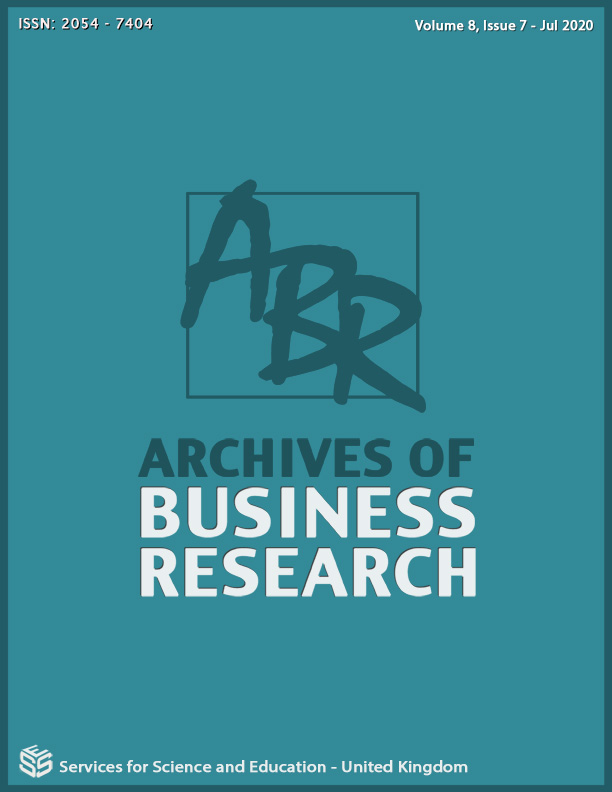Identifying the Related Mode of Working and Performance of Support Teams in Cyberjaya Telecommunication Companies
DOI:
https://doi.org/10.14738/abr.87.8554Keywords:
telecommunications, support teams, performance measurementAbstract
While previous studies tried to study the link between the mode of working (virtual versus face-to-face) and team success; less attention were given to address this topic in telecommunications companies with complex technical support tasks. This study aims to identify the relationship between mode of working and team success in telecommunications companies. This study also aims to clarify whether the team size has a significant impact on the relationship between working mode with the team success. One hundred and twenty Cyberjaya based support professionals have completed web-based surveys, offering data on support operations in virtual and face-to-face settings, and the team success in all settings. The results showed a correlation between working mode and three factors of support team success (rpb = 0,358 and 0,248; 0,395, respectively for achievement objectives, customer satisfaction and team health. In addition, the impact of team sizes on the relationships between working mode and the three factors of team success was investigated. The data analysis did not support a significant team size impact on the relationships between the mode of working and three support team success measures.
References
Brunelle, E. (2012). Virtuality in work arrangements and affective organizational commitment. International Journal of Business and Social Science, 3(2)
Castellani, S., Grasso, A., O'Neill, J., & Roulland, F. (2009). Designing technology as an embedded resource for troubleshooting. Computer Supported Cooperative Work: The Journal of Collaborative Computing, 18(2/3), 199-227.
Cavaiani, T. P. (2005). Using selected options of the Ipconfig command to teach network troubleshooting techniques. Journal of Information Systems Education, 16(3), 251-254.
Chen, C., & Messner, J. I. (2010). A Recommended practices system for a global virtual engineering team. Architectural Engineering & Design Management, 6(3), 207-221.
Duenas, J., Ruiz, J., Cuadrado, F., Garcia, B., & Parada G, H. (2009). System Virtualization Tools for Software Development. IEEE Internet Computing, 13(5), 52-59.
Duncan, I., Miller, A. and Jiang, S. (2012), A taxonomy of virtual worlds usage in education.
British Journal of Educational Technology, 43: 949–964.
Farley, S. (2013, February). Living in the virtual world: Trials and tribulations of communicating in the Internet era. Institute of Work Psychology, 1(1), 7-13.
Gibson, C. B., & Gibbs, J. L. (2006). Unpacking the Concept of virtuality: The effects of geographic dispersion, electronic dependence, dynamic structure, and national diversity on team innovation. Administrative Science Quarterly, 51(3), 451-495.
Gunter, K. S., Martha, L. M., Voigt, A., & Jonsen, K. (2010). Unraveling the effects of cultural diversity in teams: A meta-analysis of research on multicultural work groups. Journal of International Business Studies, 41(4), 690-709.
Hacker, M. E., & Lang, J. D. (2000). Designing a performance measurement system for a high technology virtual engineering team - a case study. International Journal of Agile Management Systems, 2(3), 225-232.
Harell, G. & Daim, T. U. (2009). Virtual teams and the importance of building trust. Journal of IT Professional, 11(6), 46-49.
Hoffman, J., & Bennett, N. (2018). EMPLOYEE COMMITMENT TO A SELF-DIRECTED WORK TEAM TRANSITION: SELF DETERMINATION THEORY OBSERVED IN DIRECT LABOR. 2017-2018 OFFICERS President President-Elect, 89.
Hollis, N. (2011). Globalization in context. Journal of Advertising Research, 51(3), 37-41.
Hoyte, D. S., Greenwood, R. A., & Gong, B. (2010). Team performance study: Determining the factors that influence high performance in teams. Allied Academies International Conference. Academy of Strategic Management.Proceedings, 9(1), 8-14.
Indiramma, M. M., & Anandakumar, K. R. (2009). Behavioral Analysis of Team Members in Virtual Organization based on Trust Dimension and Learning. Proceedings of World Academy of Science: Engineering & Technology, 39(3), 269-274.
Kaskinen, J. (2007). Creating a best-in-class KPI program. Strategic Finance, 89(4), 29-33.
Leung, N. K. Y., & Lau, S. K. (2007). Information technology help desk survey: To identify the classification of simple and routine enquiries. The Journal of Computer Information Systems, 47(4), 70-70-81.
Lu, M., Watson-Manheim, M., Chudoba, K. M., & Wynn, E. (2006). Virtuality and team performance: Understanding the impact of variety of practices. Journal of Global Information Technology Management, 9(1), 4-4-23.
Mihhailova, G., Oun, K., & Turk, K. (2009). Virtual work and its challenges and types. The Business Review, Cambridge, 12(2), 96-103.
Neufeld, D., Wan, Z., & Fang, Y. (2008). Remote leadership, communication effectiveness and leader performance. Journal of Group Decision and Negotiation, 19(3), 227-246.
Neuman, W. L. (2006). Social research methods: qualitative and quantitative approaches. (6th ed.). Upper Saddle River, NJ: Prentice Hall.
O'Leary, M., & Cummings, J. N. (2007). The spatial, temporal, and configurational
characteristics of geographical dispersion in teams. MIS Quarterly, 31(3), 433-452.
Piccoli, G., Powell, A., & Ives, B. (2004). Virtual teams: Team control structure, work processes, and team effectiveness. Information Technology & People, 17(4), 359-359-379.
Robert Jr, L., & Dennis and Y, A. Hung. 2009. Individual Swift Trust and Knowledge-based.
Rosen, B., Furst, S., & Blackburn, R. (2007). Overcoming barriers to knowledge sharing in virtual teams. Organizational Dynamics, 36(3), 259-273.
Stabler, D. (2020). Perception of team diversity: Determinants and consequences.






